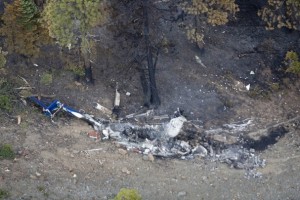Coast Guard Helicopter Crash Lone Survivor Recalls Horror
The lone survivor of last summer’s rescue-helicopter crash at LaPush recalls the horror.
By Paul Gottlieb – Peninsula Daily News staff reporter
PORT ANGELES — Coast Guard Lt. Lance Leone rescues people for a living.
But he was alone, disoriented and bobbing in chilly waters off James Island the morning of July 7.
Witnesses said the MH-60 Jayhawk rescue helicopter Leone was co-piloting had snagged thick power cables strung from LaPush to James Island across the mouth of the Quillayute River and tumbled into the water upside-down.
Leone’s survival vest allowed him to breathe underwater after his helicopter crashed, he said last week by phone from Coast Guard Air Station Sitka in Alaska, where he is the base safety officer.
But his right collarbone was broken “like a seat-belt injury,” his left arm and right leg were lacerated — and his three crewmates were nowhere in sight, he said in his first interview since the accident.
Leone, 29, shot off a flare and was rescued within five to 10 minutes by Quileute Marina Harbormaster Darryl Penn and fisherman Charles Sampson, who pulled him into their motor skiff.
“I couldn’t have swam,” Leone said.
“It didn’t quite make sense to me at the time why I was the only one floating on top and couldn’t find anyone else. It was a terrible feeling. I felt like everyone else had already been rescued.”
While the Ventura, Calif., man was recuperating at Harborview Medical Center in Seattle, he learned that his three fellow crew members had died.
They included the pilot, Lt. Sean D. Krueger, 33, of Seymour, Conn., with whom Leone attended the Coast Guard Academy in 1998.
Also killed were Petty Officer 1st Class Adam Hoke, 40, of Great Falls, Mont., and Aviation Maintenance Technician 2nd Class Brett M. Banks, 33, of Rock Spring, N.Y.
A week after the crash, a memorial service at Air Station Sitka was attended by more than 1,000 mourners.
That’s where the crew members were based and where they were headed after refueling at Coast Guard Air Station Astoria in the final leg of a cross-country trip that began in North Carolina.
The roughly 130-person base is accessible only by boat or aircraft.
Townspeople and base personnel are raising money for a monument at the air station for the deceased crew members through the Coast Guard Foundation at www.coastguardfoundation.org.
Leone, the father of a 3-year-old girl and a 1-year-old boy, spent five days recuperating, physically and emotionally.
He was thankful the Coast Guard had his children and wife by his side “almost immediately,” he said.
Leone’s son and daughter were blissfully oblivious to his injuries.
“I was all damaged, and they looked directly into my eyes and had no problems kissing me,” Leone recalled. “They did not see any damage. They looked through it all. It was cool.”
The Coast Guard interviewed Leone for “several days” during his five-day stay at Harborview for its investigation into the crash, he said.
Leone said he could not talk about the specifics of the crash, including why the helicopter was where it was when everything went wrong, while the investigation is ongoing.
The three deaths were the only Coast Guard helicopter fatalities in 2010, spokesman Robert Lanier of 13th Coast Guard District Seattle said Friday.
The district’s investigative report on the incident is being reviewed by Coast Guard headquarters in Washington, D.C., he said.
It was one of three Coast Guard helicopter crashes in 2010, a number that generated a “safety stand down” ordered by Coast Guard Commandant Adm. Robert J. Papp. “He wanted to make sure we were sure of what the safety procedures were,” Lanier said.
Lanier said the power lines that Leone’s helicopter hit have been removed. The James Island safety lights that the lines powered are now connected to an on-island generator.
As for Leone, he said he’s fully recovered from his injuries.
He’s been through six months of physical therapy for his bodily injuries and six months of mental-health counseling sessions for acute traumatic stress. “If you don’t deal with it while it’s recent, it becomes like a skeleton in the closet,” Leone said.
“The Coast Guard has been excellent at rehabilitating me,” he added.
“What helps get you through is family and friends. When you go home and hug your kids, that’s how you get through all this stuff”.

